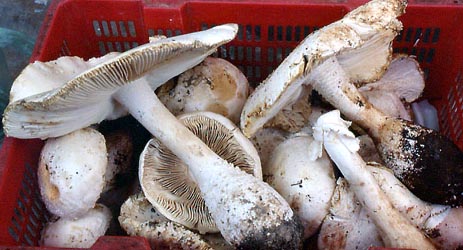|
[ Section Lepidella page. ] [ Amanita Studies home. ] [ Keys & Checklist/Picturebooks ] Amanita virgineoides Bas"False Virgin's Lepidella"
Technical description (t.b.d.) BRIEF DESCRIPTION: Basidiocarps medium-sized to large. Pileus 70 - 150 (-200) mm wide, convex to applanate, sometimes concave, white, covered with white, conical to pyramid volval remnants 1 - 3 mm high and wide; the cap margin is smooth and appendiculate; and the context is white and unchanging. The gills are free to subfree and white to cream; the short gills are attenuate. The stipe is 100 - 200 x 15 - 30 mm, subcylindric or aslightly attenuate upwards, white, covered with white floccose squamules; the context is white; the stipe's basal bulb is 30 - 40 mm wide, ventricose, ovoid to subglobose, with its upper part covered with white, verrucose to granular volval remnants. The annulus is white; its upper surface bears fine, radial striations; and its lower surface, verrucose to conical warts. The annulus is often broken during expansion of the cap. The spores measure (7.0-) 8.0 - 10.0 (-11.5) x (5.5-) 6.0 - 7.5 (-8.5) Ám and are broadly ellipsoid to ellipsoid and amyloid. Clamps are common at bases of basidia. The species was originally described from Japan. Amanita virgineoides is also known from China and South Korea. ZLY's photograph depicts a gathering of this species for sale in a market Bas (1969) defined his stirps Virgineoides based on the present species. This stirps also includes A. miculifera Bas & Hatan. and A. gracilior Bas ex Bas & Honrubia. -- Zhu L. Yang and R. E. Tulloss Photo: Zhu L. Yang (Yunnan Province, China) [ Section Lepidella page. ] [ Amanita Studies home. ] [ Keys & Checklist/Picturebooks ] Last change 22 March 2009. |
